Retinol Face Moisturizer
| Phase | Ingredient | Percent (%) | Weight (g) |
|---|---|---|---|
| Phase A | Water | 55.5 | 55.5 |
| Glycerin | 4.0 | 4 | |
| Xanthan Gum | 0.4 | 0.4 | |
| Allantoin | 0.3 | 0.3 | |
| Phase B | Coco Caprylate | 8.0 | 8 |
| Isoamyl Laurate | 4.0 | 4 | |
| Squalane | 5.4 | 5.4 | |
| Myrica Wax | 2.0 | 2 | |
| Cetyl Alcohol | 3.0 | 3 | |
| Emulsifier Methyl Glucose Sesquistearate | 5.0 | 5 | |
| Phase C | Propanediol | 2.0 | 2 |
| Pentylene Glycol | 1.0 | 1 | |
| Betaine | 1.0 | 1 | |
| Retinol (INCI - Retinyl Palmitate, Tocopherol) | 0.8 | 0.8 | |
| Vitamin E | 0.2 | 0.2 | |
| Preservative Cosgard (INCI - Benzyl Alcohol, Dehydroacetic Acid, Aqua) | 0.8 | 0.8 | |
| Mandelic Acid | 0.8 | 0.8 | |
| Green Tea Extract | 2.0 | 2 | |
| Cucumber Extract | 2.0 | 2 | |
| Silica (Cosmetic Grade Silica Microspheres) | 1.0 | 1 | |
| Sodium Gluconate | 0.4 | 0.4 | |
| Lavender essential oil | 0.4 | 0.4 |
What is Retinol and How Does it Work?
Retinol, a form of Vitamin A, has become a gold standard in skincare, especially in anti-ageing and acne treatments. Its popularity stems from its ability to stimulate cell turnover, reduce fine lines, and improve skin texture. However, using retinol requires understanding its strengths, doses, and safety, as it’s a potent ingredient that doesn’t suit everyone’s skin.
Retinol is part of the retinoid family, a group of compounds derived from Vitamin A. When applied to the skin, retinol converts into retinoic acid, a highly active form of Vitamin A that encourages the skin to regenerate. By promoting cell turnover, retinol helps reduce signs of aging, prevents clogged pores, and smooths skin texture.
Common Uses of Retinol in Cosmetics:
- Fine Lines and Wrinkles: Retinol stimulates collagen production, improving skin elasticity and reducing fine lines.
- Acne: Retinol keeps pores clear and minimizes the appearance of acne scars.
- Hyperpigmentation: It fades dark spots and evens skin tone by promoting cell renewal.
Dosages in Skincare Products:
- Low Concentration (0.1% to 0.3%): Suitable for beginners, these doses improve skin texture and target mild wrinkles with minimal irritation.
- Medium Concentration (0.5% to 1%): This range is effective in anti-aging treatments and is recommended for those with experience.
- High Concentration (1%+): Potent doses are typically used under professional supervision and can address severe signs of aging.
Safety and Precautions
- Potential Side Effects of Retinol
While highly effective, retinol can be irritating. Common side effects include redness, peeling, dryness, and sensitivity to sunlight. This is why beginners are advised to start with lower doses, use retinol at night, and always apply sunscreen during the day. Retinol creams are usually used more in winter when there is less sun exposure.
- Who Should Avoid Retinol?
Pregnant or Nursing people: Retinol may pose risks during pregnancy, and it's best avoided unless advised by a healthcare professional. Sensitive or Compromised Skin: Those with eczema, rosacea, or highly sensitive skin should proceed cautiously, as retinol can exacerbate these conditions.
- Who Can Benefit Most from Retinol?
Mature Skin: Retinol’s anti-aging benefits are highly effective for mature skin showing fine lines and wrinkles. Acne-Prone Skin: Retinol can help minimize breakouts and reduce pore size. Uneven Skin Tone: It fades hyperpigmentation and improves skin tone, making it suitable for sun-damaged or scarred skin.
You can read more about Retinol here:
- https://pubmed.ncbi.nlm.nih.gov/38002296/
- https://pubmed.ncbi.nlm.nih.gov/32428912/
- https://pubmed.ncbi.nlm.nih.gov/36220974/
If you want to learn more about the basics of making an emulsion, check this post here

Now, I'll go over the ingredients in this formula and give you some alternatives:
Allantoin is a gentle skin-soothing agent known for calming and repairing irritated skin. It promotes cell regeneration and reduces redness. It hydrates, protects, and softens the skin, making it ideal for sensitive skin types. Allantoin is especially useful in retinol formulations, as it helps reduce potential irritation and dryness caused by retinoids. Allantoin provides a soothing effect to balance retinol’s intensity, enhancing the formula’s gentleness and allowing a wider range of skin types to use the product comfortably. To dissolve the Allantoin it needs to be added to the heated water phase, around 50-55°C for 20 minutes. You can replace the Allantoin with Panthenol (Pro-Vitamin B5) if you do - add the Panthenol in the cool-down phase (phase C).
Coco Caprylate is a light, coconut-derived emollient that provides a silky-smooth feel on the skin. It’s non-greasy and absorbs quickly, leaving a soft finish. It helps moisturize and soften the skin without clogging pores, making it suitable for all skin types, including oily and acne-prone skin. Its lightweight texture enhances the overall sensory experience of the moisturizer. Coco caprylate adds a luxurious feel to the moisturizer, balancing hydration with a smooth, non-greasy finish. It helps the formula feel silky and lightweight on the skin. You can use Caprylic/Capric Triglyceride or Jojoba oil instead.
Isoamyl laurate is a plant-based, low-viscosity emollient often used as a silicone alternative. It provides a smooth, velvety texture and helps the moisturizer glide effortlessly. This ingredient locks in moisture while delivering a silky finish. It also reduces friction, making the moisturizer spread more evenly and preventing tugging on the skin. Isoamyl laurate improves the feel of the moisturizer, making it lightweight, smooth, and easy to spread. Its quick absorption complements the other emollients, adding to the non-greasy finish of the product. You can use Squalane instead.
Squalane is a lightweight, non-comedogenic emollient that mimics the skin’s natural oils. It hydrates, softens, and provides a barrier to lock in moisture. Squalane is known for its moisturizing properties without a greasy feel, making it suitable for all skin types. It also has antioxidant properties that protect the skin from environmental damage and prevent moisture loss. Squalane enhances hydration, helping balance retinol’s drying effects. Its stable, lightweight formula ensures lasting moisture without clogging pores or feeling heavy. You can use Marula Oil or Argan oil to replace it.
Myrica wax, derived from bayberries, is a plant-based wax that is a natural thickener and stabilizer. It provides structure to the formula and improves its stability. This wax gives the moisturizer a firm yet spreadable texture, allowing for a smooth application. Myrica wax adds a creamy texture and thickness to the formula without feeling too heavy. It enhances stability and contributes to the rich feel of the moisturizer. You can replace it with beeswax, although the beeswax has a more sticky feel in the final product.
Cetyl alcohol is a fatty alcohol that works as an emollient and thickener, giving the cream a smooth, creamy texture. Unlike drying alcohols, cetyl alcohol conditions and softens the skin, enhancing the texture of the moisturizer. It also helps to stabilize emulsions, making the formula more durable. Cetyl alcohol adds a velvety finish, allowing the cream to feel luxurious and smooth on the skin while providing a conditioning effect. You can use Stearyl Alcohol instead.
Methyl Glucose Sesquistearate is a mild, non-ionic emulsifier derived from natural glucose and vegetable oil. Methyl Glucose Sesquistearate is very mild and suitable for sensitive skin. Methyl Glucose Sesquistearate provides a subtle moisturizing effect, helping to keep the skin soft and hydrated. Methyl Glucose Sesquistearate imparts a smooth and silky texture; It gives a lightweight finish. You can use Sucrose Stearate instead; if you use Sucrose Stearate as the emulsifier, it is recommended to add it to the water phase, check the Ultra Facial Cream formula that uses Sucrose Stearate as an emulsifier. You can also use Olivem 1000 as an emulsifier - it has similar qualities to Methyl Glucose Sesquistearate, take into consideration that Methyl Glucose Sesquistearate is less dense with a silky feel which helps to achieve a lighter consistency and a smoother feel in the final product. Every emulsifier will give a different consistency and texture to the final product.
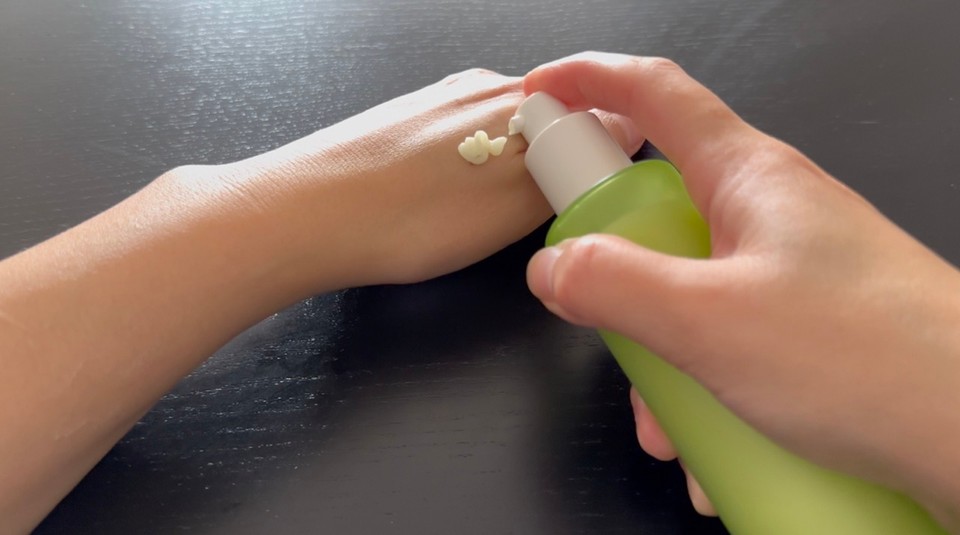
Propanediol is a hydrating solvent that helps improve the penetration of other ingredients. It enhances the moisturizer’s feel, providing light hydration and boosting the absorption of actives like retinol. It’s also a preservative booster, adding to the formula’s shelf stability. Propanediol amplifies hydration and ensures active ingredients are effectively delivered to the skin, maximizing the benefits of the moisturizer. You can swap the Propanediol with Butylene Glycol.
Pentylene glycol is a humectant and preservative booster that enhances the moisturizer’s moisture-retention abilities. It improves hydration and supports the preservation system, helping keep the product fresh for longer. You can use Propylene Glycol or glycerin instead.
Betaine is a powerful humectant derived from sugar beets. It helps attract and retain moisture in the skin, keeping it hydrated and plump. In a retinol cream, this added hydration is crucial because retinol can sometimes cause dryness and peeling. Betaine has a soothing effect on the skin, which helps reduce the potential irritation associated with retinol. It acts as an osmolyte, balancing skin cells' hydration levels and supporting the skin barrier, which minimizes sensitivity and dryness. You can use Sodium PCA instead.
Retinol is a potent anti-aging ingredient that increases cell turnover and collagen production, reducing fine lines and wrinkles. Over time, it improves skin texture, smoothness, and firmness. However, retinol can be irritating, so it should be balanced with soothing ingredients (such as Allantoin). Retinol is the primary active ingredient in this moisturizer, targeting signs of aging and improving skin’s overall appearance. In this formula, I used 0.8% retinol; if you wish to start with a lower dose, use only 0.5% retinol and add the difference (0.3%) to the distilled water.
Vitamin E is a powerful antioxidant that protects skin from environmental damage. It prevents free radical damage, extends the stability of retinol, and provides nourishing benefits. If you don't have Vitamin E, you can use Rosehip seed oil instead.
Mandelic Acid is an alpha-hydroxy acid (AHA) derived from bitter almonds, celebrated for its gentle yet effective exfoliating properties. Compared to other AHAs like glycolic or lactic acid, mandelic acid has a larger molecular size, which makes it penetrate the skin more slowly, reducing the risk of irritation. This slower penetration makes it especially suitable for sensitive skin, pairing it with potent actives like retinol.
Mandelic acid promotes gentle exfoliation, removing dead skin cells to reveal fresh, radiant skin. This effect complements retinol, accelerating cell turnover and creating a smoother, more even complexion.
Mandelic acid effectively reduces hyperpigmentation, fine lines, and uneven skin texture. By fading dark spots and brightening the skin, it enhances the overall appearance, working synergistically with retinol to improve skin tone.
Unlike stronger AHAs, mandelic acid’s large molecular structure makes it ideal for sensitive skin or skin that’s already acclimating to retinol. It delivers exfoliation benefits with less likelihood of irritation, dryness, or redness—a critical feature when pairing with retinol.
Mandelic acid has mild antibacterial properties, making it beneficial for those with acne-prone skin. Combined with retinol, which also helps reduce breakouts by unclogging pores, it provides a comprehensive approach to clear, smooth skin. AHAs, including mandelic acid, can help improve the skin’s moisture levels. Mandelic acid assists in strengthening the skin barrier, which retains hydration and prevents transepidermal water loss. In a retinol moisturizer, this helps counterbalance retinol’s drying effects. You can replace it with Lactic acid.
Green Tea extract is rich in polyphenols, specifically catechins like epigallocatechin gallate (EGCG), which are powerful antioxidants. These compounds protect the skin from free radicals, help calm inflammation, and reduce redness. Green tea is also known for its anti-aging benefits, as it protects against environmental stressors, reduces signs of aging, and supports collagen production. You can use Chamomile extract instead.
Cucumber extract is highly hydrating and rich in vitamins (such as vitamin C and folic acid), minerals, and antioxidants. Known for its cooling and anti-inflammatory properties, it reduces puffiness, calms redness, and refreshes skin. Cucumber also helps maintain the skin's natural moisture barrier, keeping it hydrated and smooth. You can use Aloe Vera extract or Oat extract to replace it.
Silica is a mineral that helps absorb excess oil on the skin's surface, giving a matte finish. It also acts as a light diffuser, creating a smoother skin appearance by minimizing the look of fine lines and pores. Additionally, silica contributes to a silky texture, helping the product glide smoothly on the skin and leaving a soft finish. In this moisturizer, silica helps to create a smooth, non-greasy finish, which is especially beneficial in a product containing retinol, as it can balance the formulation for those with combination or oily skin types. Silica's ability to absorb oil without stripping moisture makes it an ideal addition for creating a refined, polished look that can counterbalance any shine. You can use Rice powder or Arrowroot powder instead (cosmetics grade).
Sodium Gluconate acts primarily as a chelating agent, binding metal ions in the formula to prevent oxidation and maintain product stability. This function helps extend the shelf life of the moisturizer, preserving the efficacy of active ingredients like retinol. Additionally, sodium gluconate has mild humectant properties, helping to maintain skin hydration. You can use Disodium EDTA instead, but you'll need to adjust the amount of Disodium EDTA to 0.3% (add the remaining 0.1% to the distilled water in phase A).
A quick note on Chelating agents: they are essential ingredients in many skincare formulations, including face creams. Their primary role is to bind and neutralize metal ions, such as iron, calcium, and magnesium, which can be present in both the water and raw materials used in the formulation. These metal ions can have several negative effects on the stability and efficacy of the product. Metal ions can catalyze oxidative reactions, leading to the degradation of active ingredients, such as antioxidants, vitamins, and oils. Chelating agents bind to these metals, preventing them from destabilizing the formula and extending the product's shelf life. Chelating agents can enhance the effectiveness of preservatives by preventing metal ions from interfering with their activity. Without chelating agents, metal ions can cause the product to discolor, develop an unpleasant odor, or separate, leading to a compromised product that may be less effective or aesthetically pleasing.
When you make DIY skin care products and cannot find a chelating agent to add to your products, there are a few actions you can take to help maintain the stability and quality of your formulation:
Always use distilled water (Distilled water is free of impurities, including metals).
Choose high-quality, well-refined oils and ingredients that are less likely to contain metal contaminants.
Incorporate antioxidants like Vitamin E, Grapefruit extract or Green Tea extract into your formula. While they're not a direct replacement for a chelating agent, these antioxidants play a crucial role in slowing down the degradation process.
The formula may have a shorter shelf life without a chelating agent. Making smaller batches of the product ensures it is used up while still fresh and effective.In general, for DIY products, it is recommended to make small batches and use up the product after three months.
Protect the product from light, heat, and air exposure, which can accelerate the degradation of the formulation. Using airtight, dark-colored containers can help extend the product's shelf life.
Monitor the pH and visual appearance of the cream over time. If you notice any significant changes in color, smell, or texture, it may be a sign that the product is beginning to degrade.
I used Cosgard as the preservative. If you use another preservative, use it according to your supplier's instructions (if your chosen preservative should be 1%, reduce the 0.2% from the distilled water).
I used Lavender essential oil; you can use other fragrance or essentials oil instead or skip it and make an unscented moisturizer. If you skip the essential oil, add 0.4% to the squalane to adjust the formula. Make sure you use skin-safe essential oils or fragrance oils.
The final pH should be 5-5.5. To read more about pH in cosmetics, check this post here.
Method:
- Make a slurry in a heat-resistance beaker by combining the glycerin and the gum. Creating a slurry by mixing glycerin and xanthan gum before adding water helps prevent the gum from clumping when it is added to water. The slurry method also ensures that the xanthan gum is fully hydrated and dispersed evenly in the mixture.
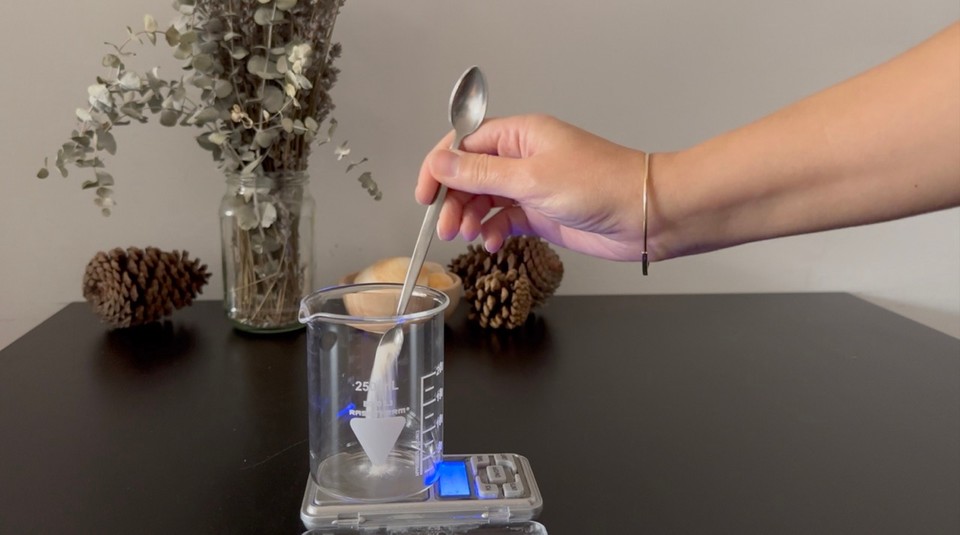
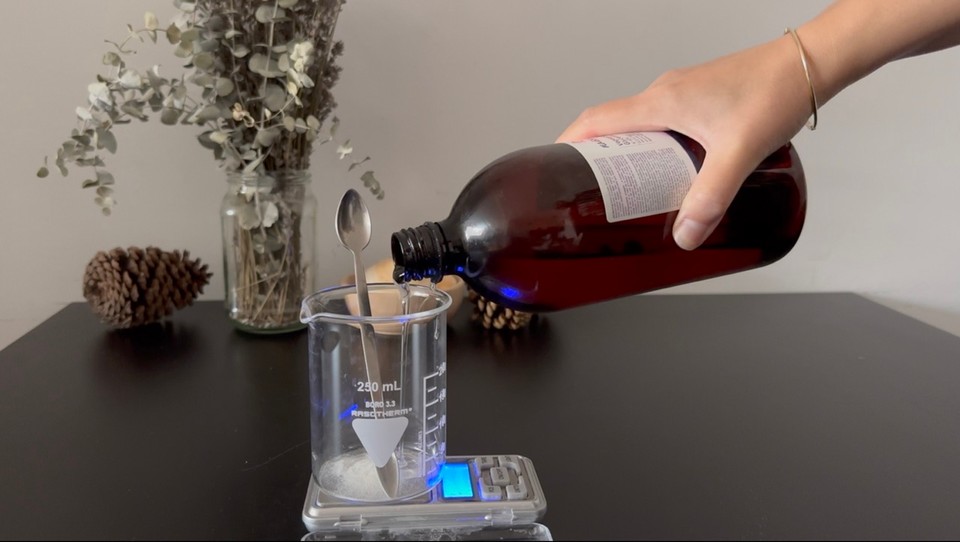
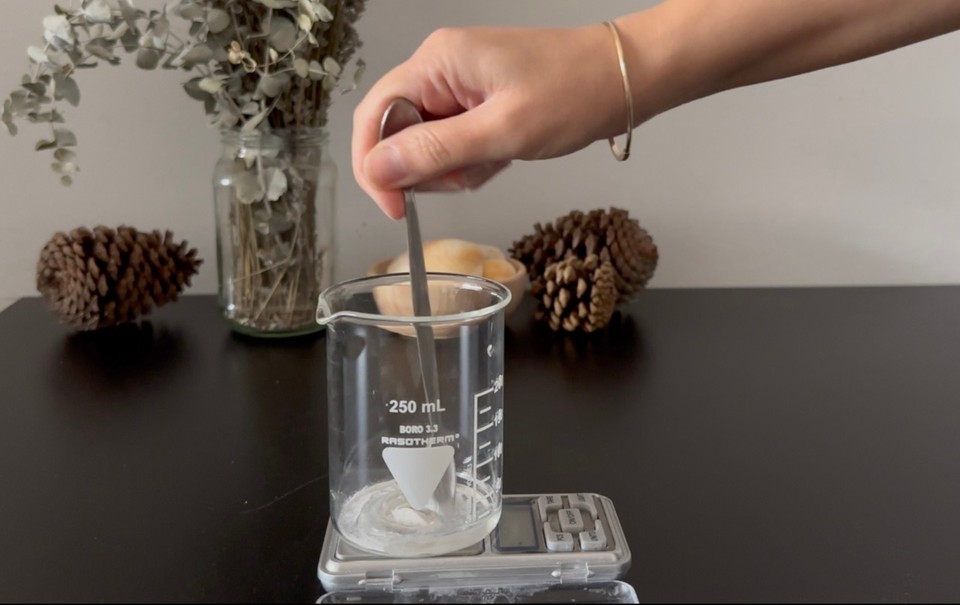
- Add the distilled water and the Allantoin and mix.

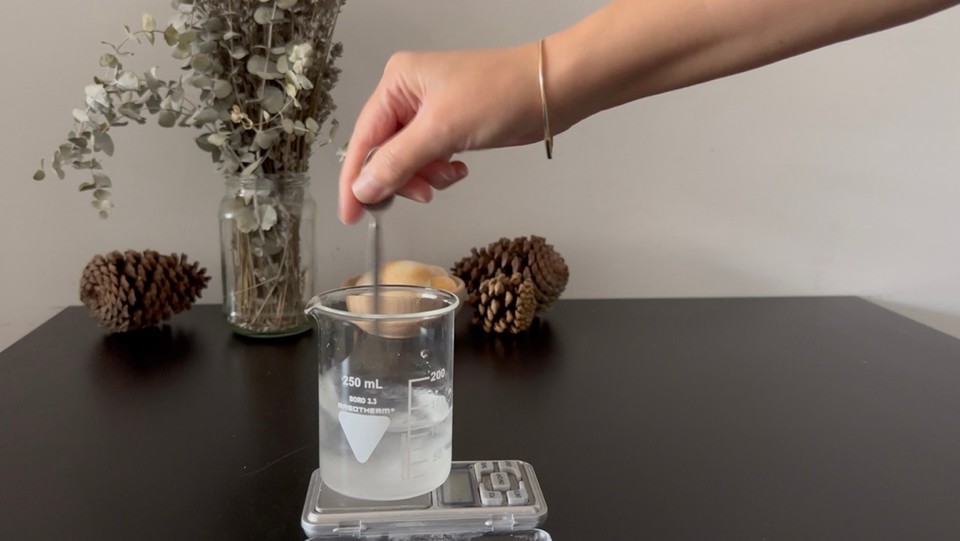
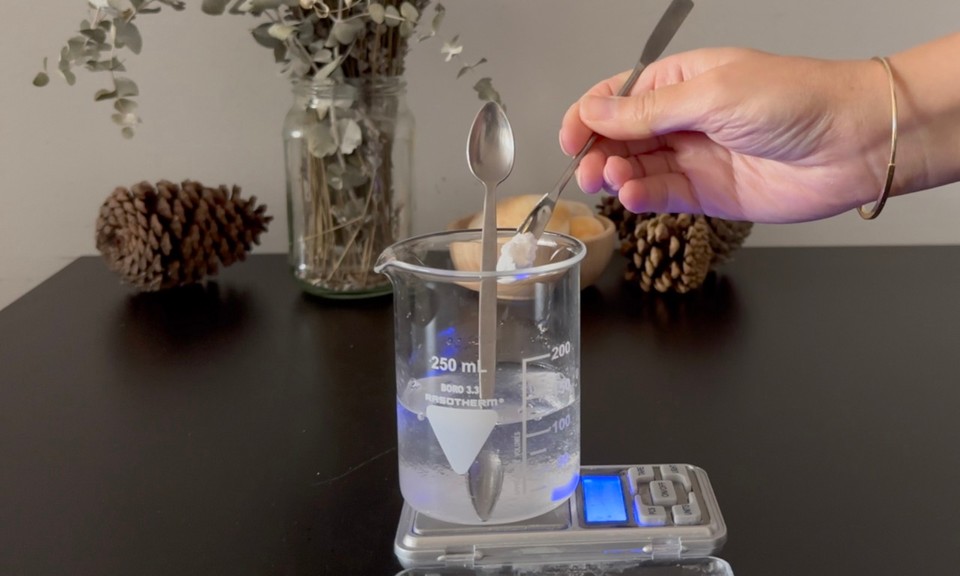
- Cover the water phase with aluminum foil to minimize evaporation. (when working with bigger batches, you should scale your water phase before heating and after removing it from the heat. Calculate the water evaporated during the heating and add the missing amount to the water phase beaker).

- In another heat resistance beaker, add phase B ingredients.

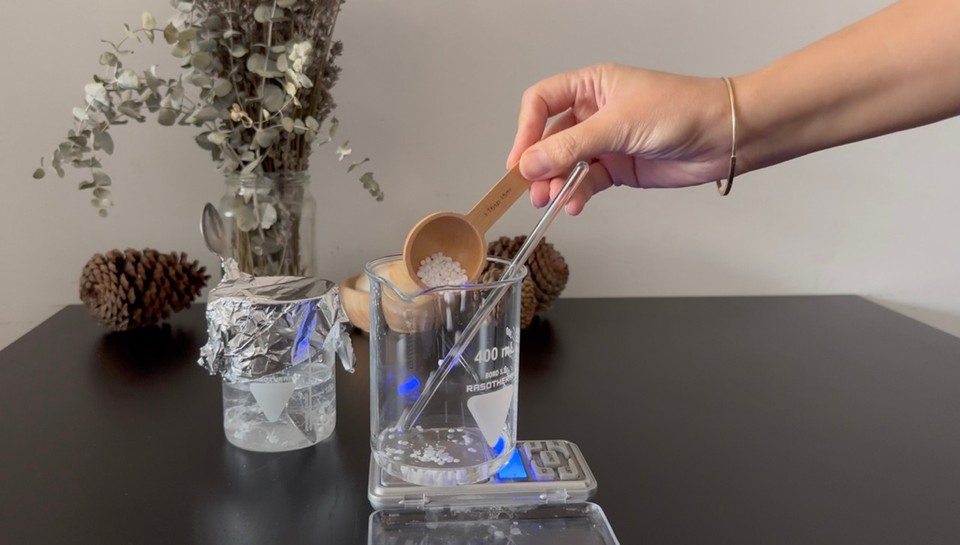


- Place phases A and B into a double boiler for 15-20 minutes on low-medium heat (around 55°C).
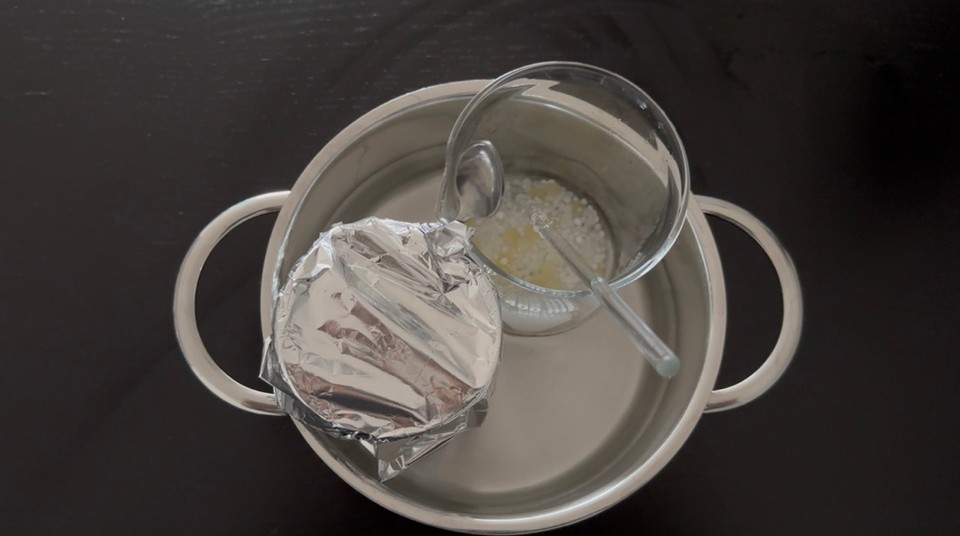
- Prepare phase C in a different container, mix everything and set aside.
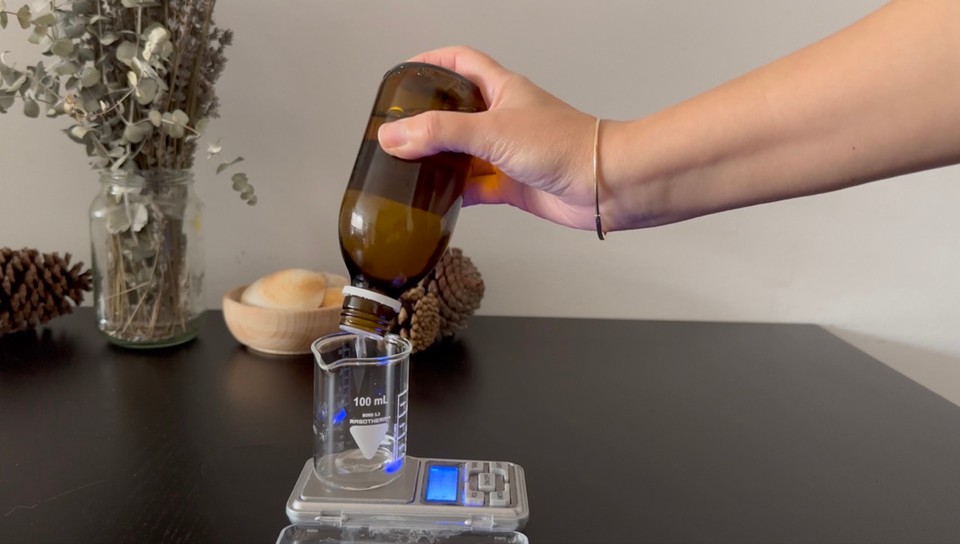
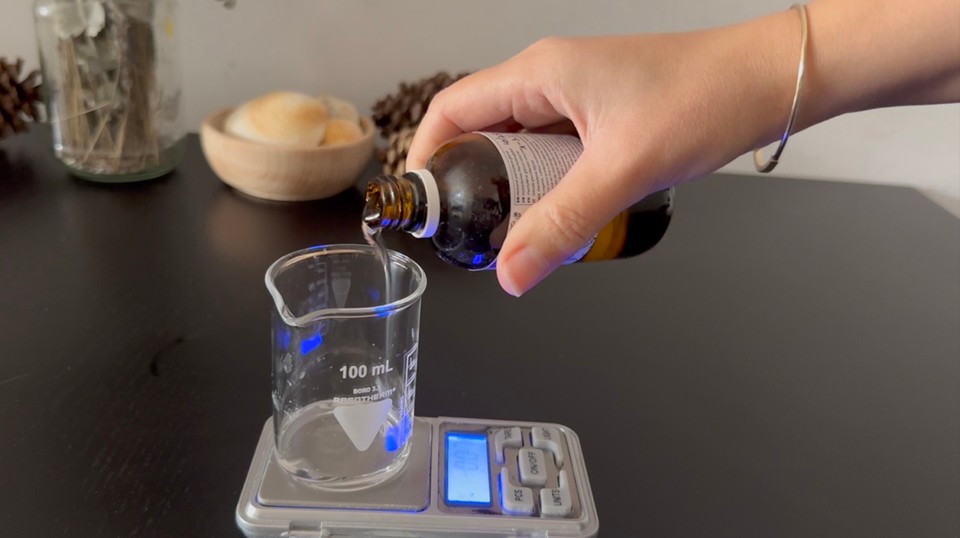


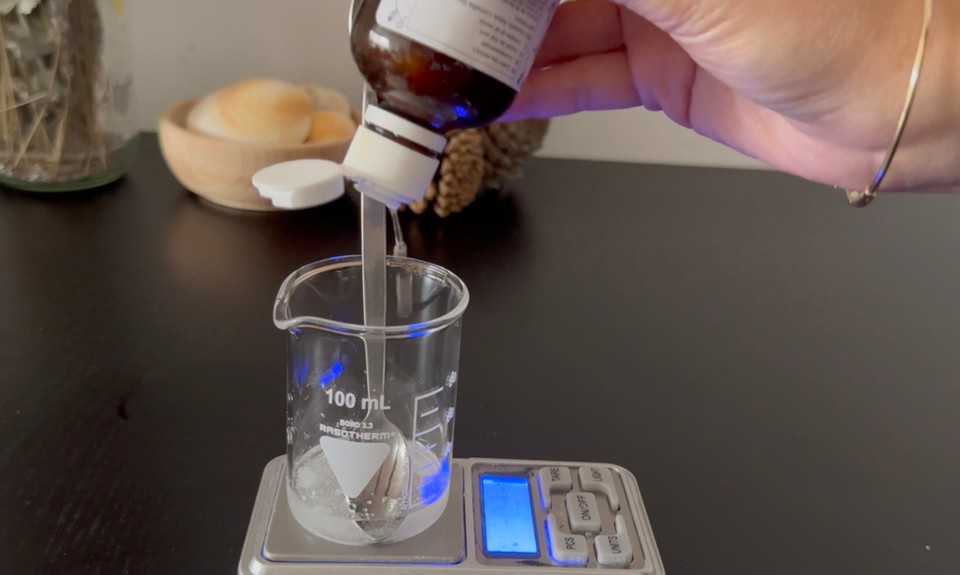
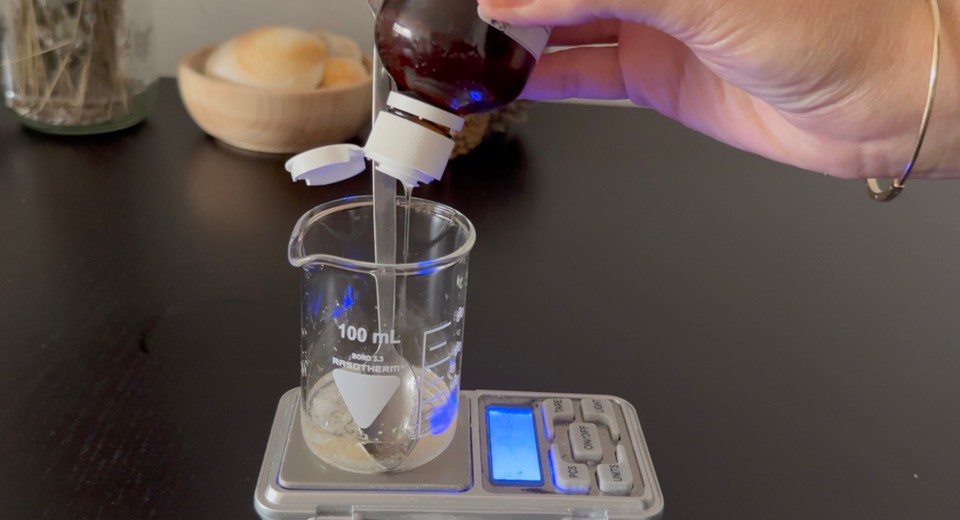

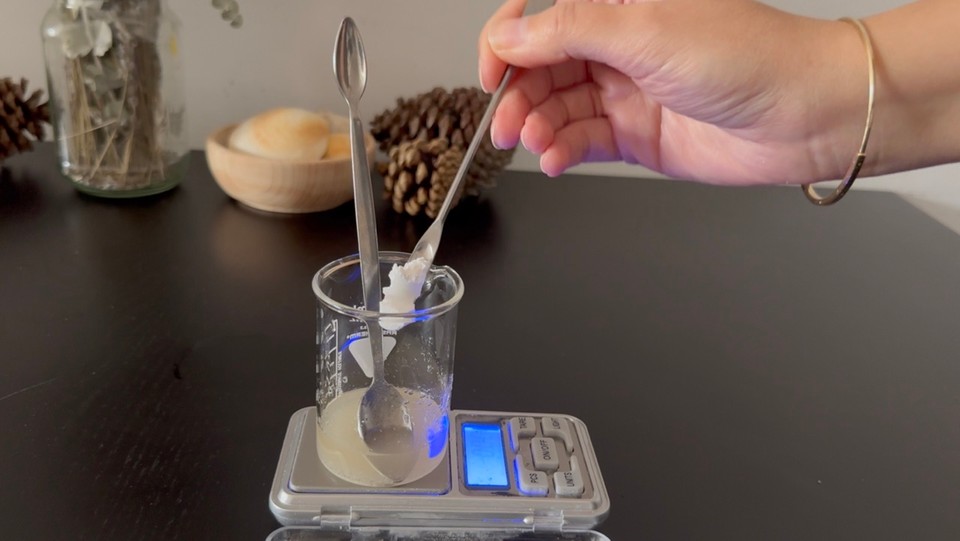
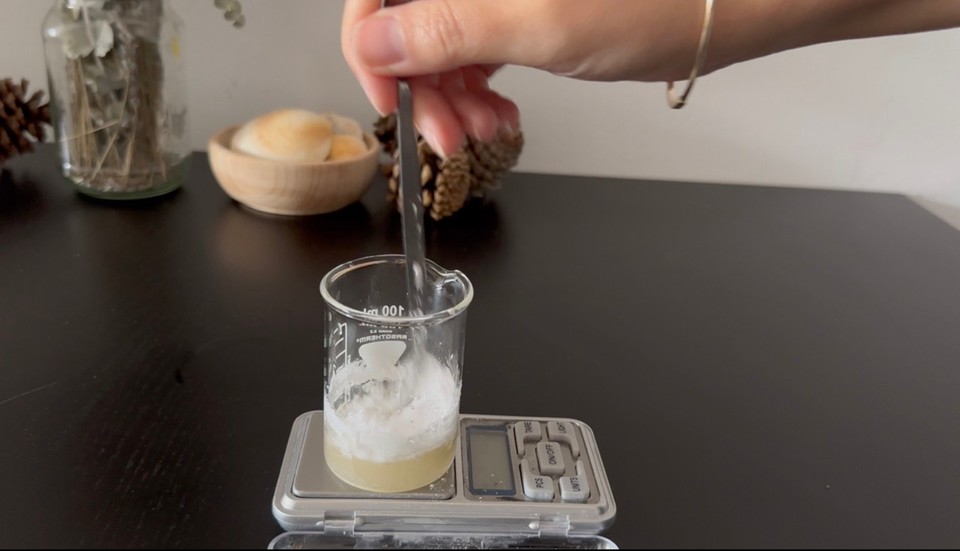


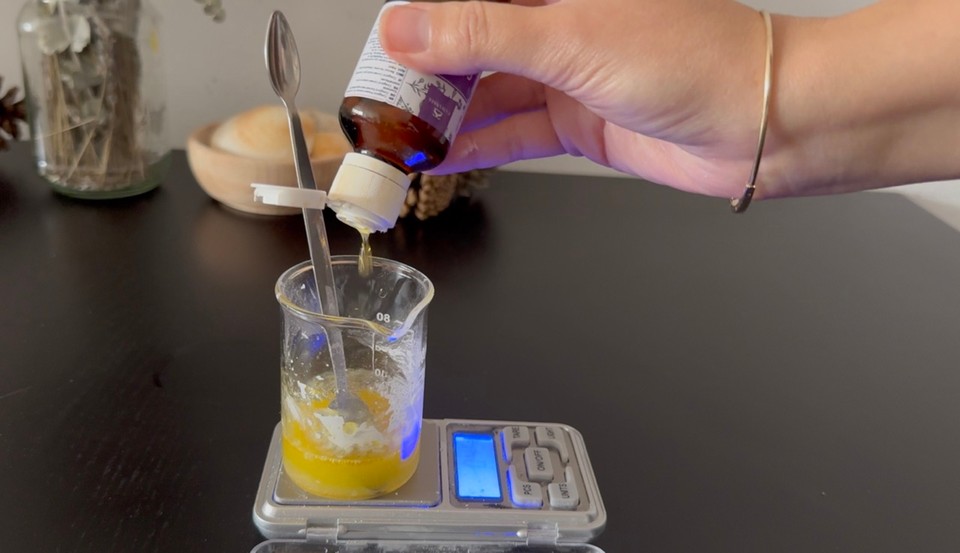
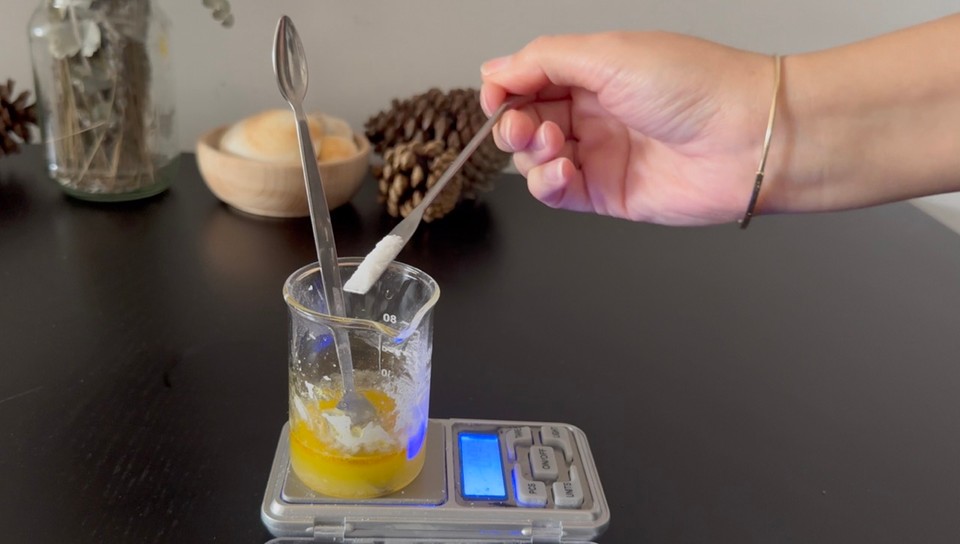

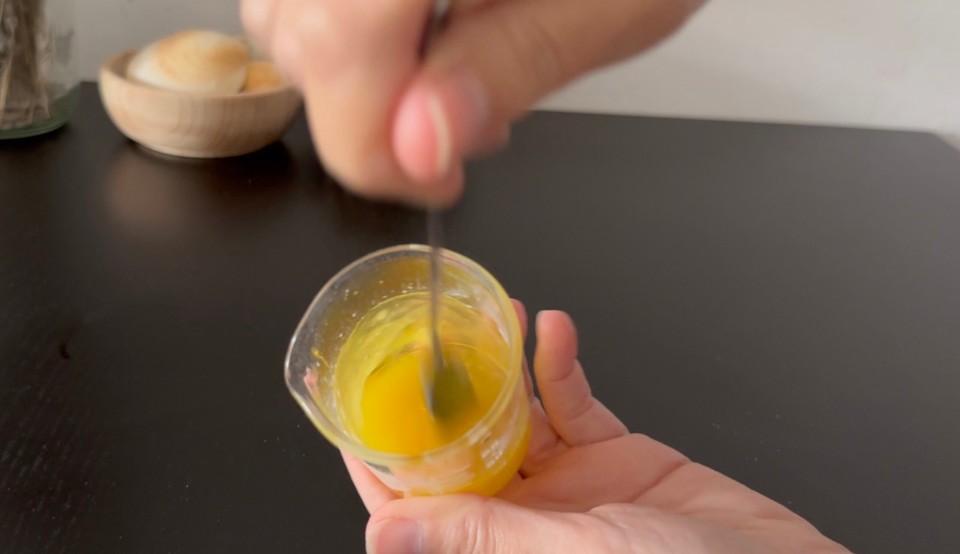
- Remove phases A and B from the heat.
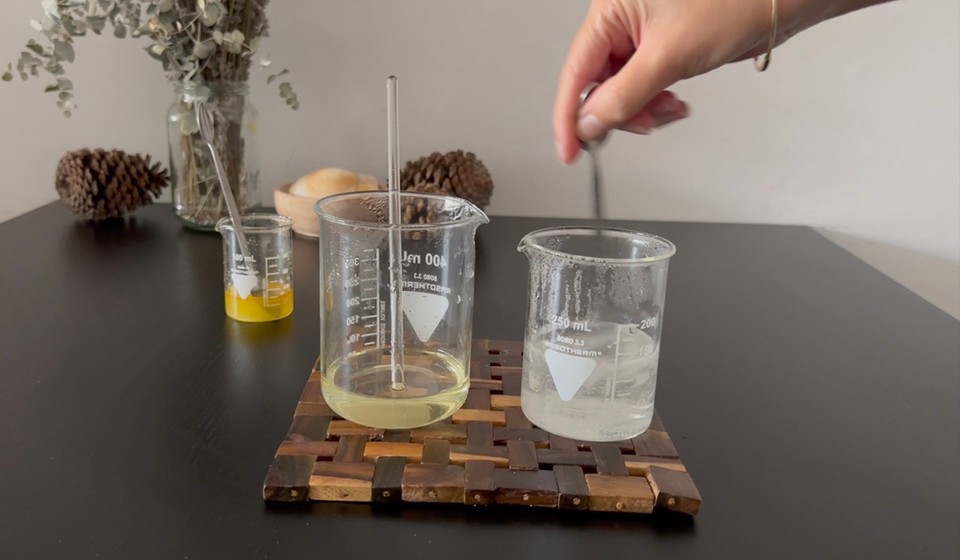
- Combine phases A and B with an immersion blender for 1-2 minutes. Leave the emulsion to cool.
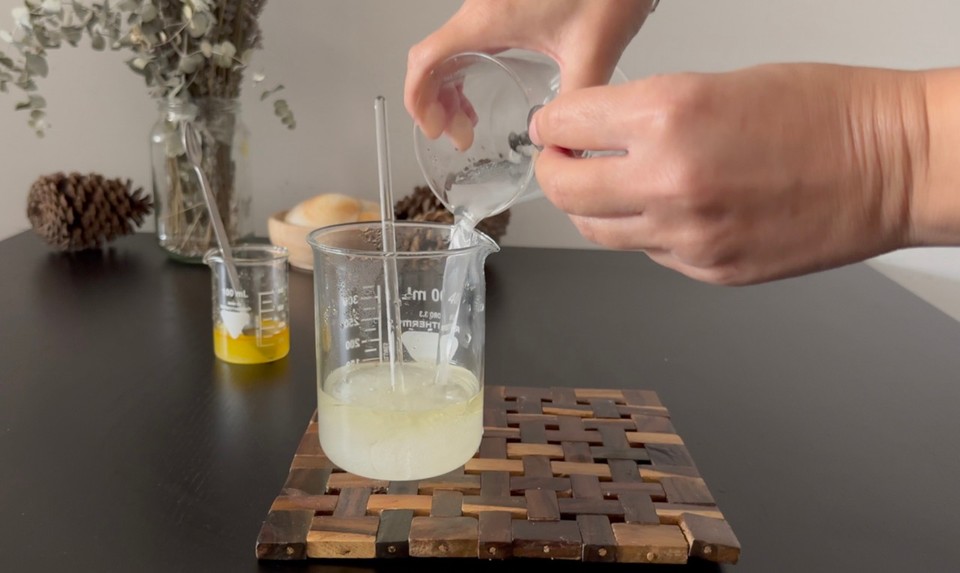
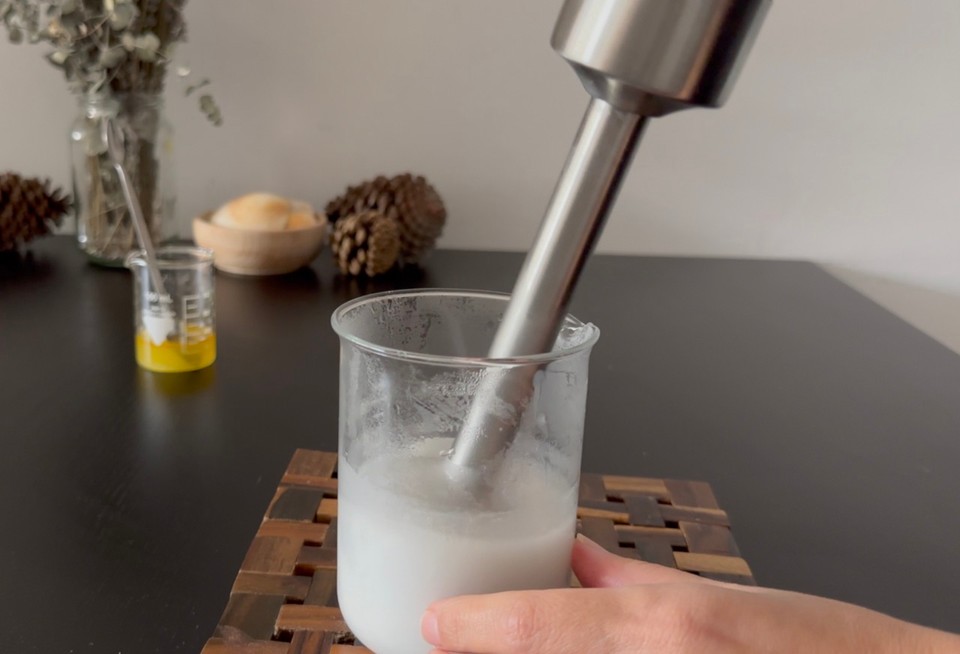
- When the emulsion has cooled to 40°C or less, Add phase C and mix (I used a milk frother for 20-30 seconds to combine all).
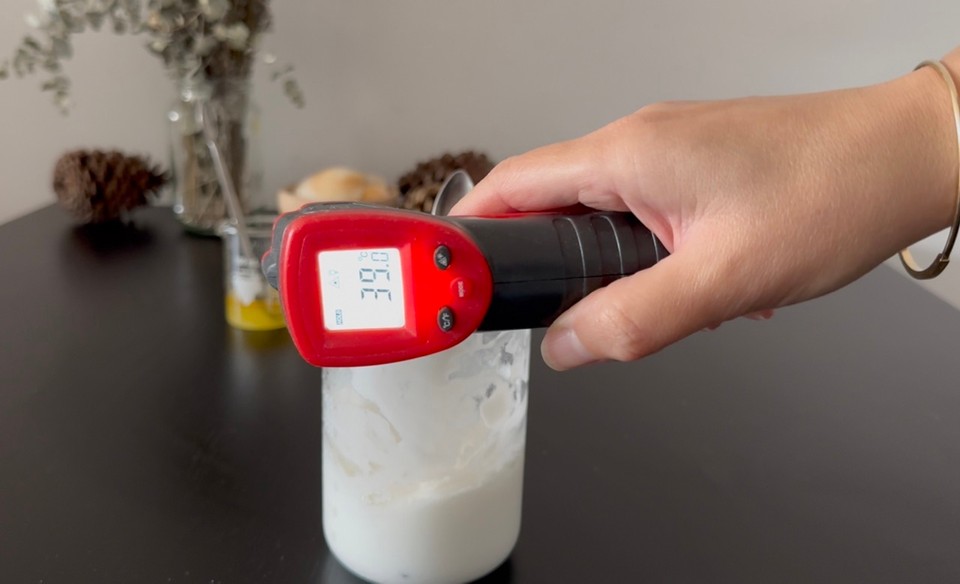
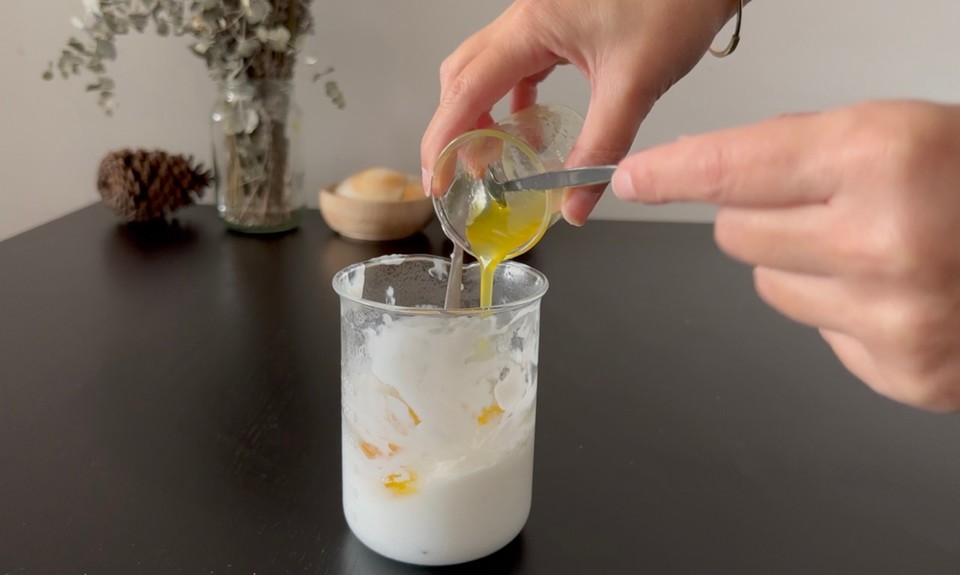

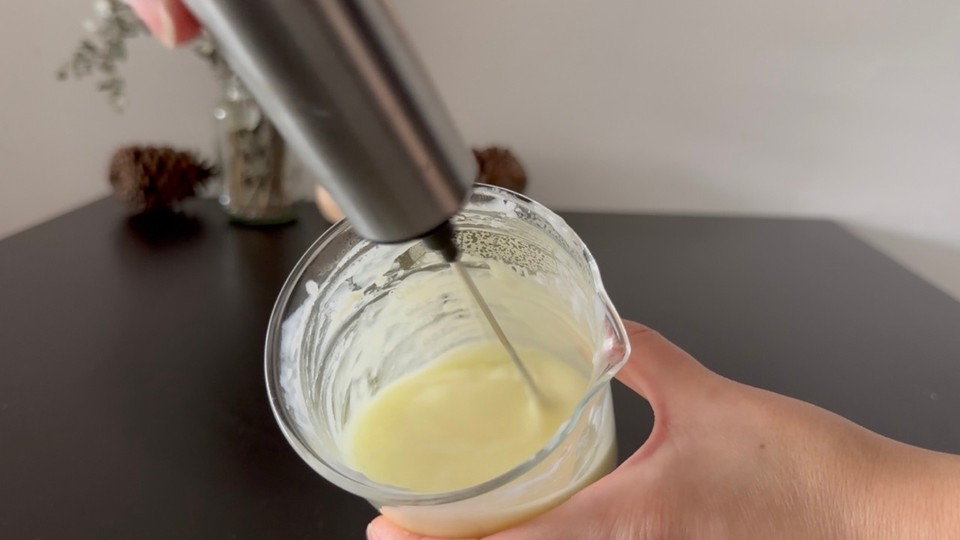
- Check the pH and adjust if necessary. More on pH adjustments here. Final pH should be 5-5.5.
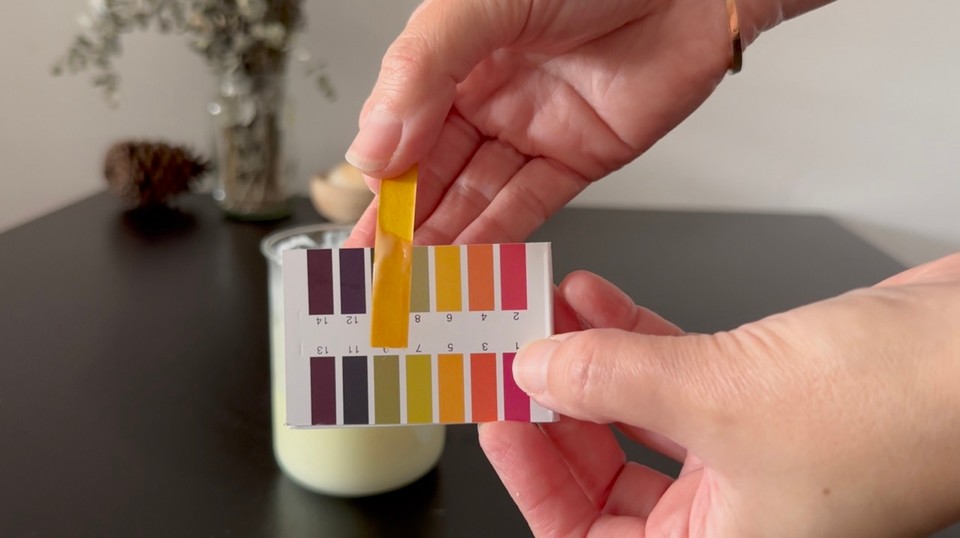
- Let the emulsion set for 6 hours. Pour into a container.


